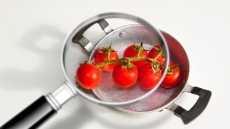New culture medium to fight salmonella war
as the food industry continues to fight against the prevalent
pathogen salmonella.
The Basingstoke-based supplier of diagnostic products claims its Oxoid Xylose Lactose Tergitol 4 (XLT-4) agar product is "ideal for the isolation and identification of salmonella from food and environmental samples."
Carried in eggs, poultry, raw milk and chocolate the salmonella bacteria can cause bloody diarrhea, abdominal cramps and in extreme cases kidney failure.
Incidents are a major problem in most countries across the globe, leading to hefty costs for the public and private sector.
Recent estimates from the US put total annual costs (medical care and lost productivity combined) of the pathogen at a massive $2.3 billion (€1.85bn). And salmonella food poisoning costs the British economy a considerable £1 billion a year.
And in industrialised countries, the percentage of people suffering from foodborne diseases each year has been reported to be up by 30 per cent.
"The enhanced selectivity of XLT-4 Agar reduces the need for further identification procedures, saving time and money, and results in fewer false presumptive positive colonies when compared to other Salmonella plating media,"claims the UK firm.
The detection of Salmonella species is often complicated by the presence of background flora and other Enterobacteriaceae on an agar plate, it adds.
The firm asserts that its new product "inhibits many organisms that can be problematic on other plating media."
In addition, apparently biochemical and pH changes within the medium allow Salmonella spp. (black colonies) to be differentiated from organisms, such as E. coli (yellow colonies) and Shigella spp. (red colonies).
Tougher regulatory standards and the increased reporting of food contamination in supermarkets and processing plants has forced food firms to put a higher priority on safety, shelf life and cleanliness.
The trend has fuelled the demand for more stringent testing and tracing of food products along the supply chain to the consumer.
And food firms are making heavy investments in food safety and diagnostic tools. In August, for example, leading ingredients firm Danisco said it would inject a further €5 million into German diagnostics company Profos through its venture capital arm Danisco Venture.
The food sector is now the largest segment within the industrial microbiology market. It is more than double the size of any of the other industrial segments including the pharmaceutical, personal care products, beverage, environmental, and the industrial process sectors.
SCI estimates that the global food microbiology market will top $1.65 billion this year, representing over 625 million tests.























